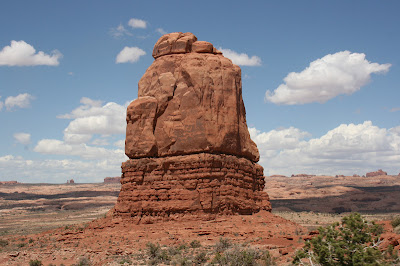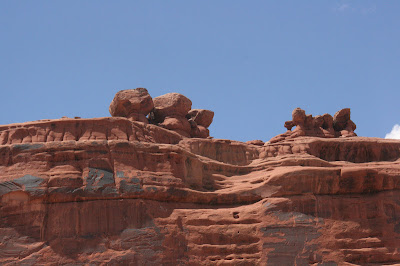Yummy, another KOA that makes a lovely pancake breakfast for the kids to eat!! They absolutely love it because we don’t have time to make pancake and they had all you can eat this morning.
Because we were too late getting in last night we wanted to stop in the town of Durango on our way to Mesa Verde National Park. I had heard that it was very quaint town, and whoever told me that was right. The Denver and Rio Grande Railroad organized the town in 1881 and it became an old mining town with the oldest working steam locomotive in the United States. The train was used for mining silver out of the mountains and became known as the Durango & Silverton Narrow Gauge Railroad. The elevation is 6512 feet.
We went to the adorable little train museum that had some of the original Rio Grande steam engines. And it had the biggest model train town that I have ever seen. It was a great little museum and even better, it was free.
Downtown Durango had many adorable little gift shops. It reminded me of downtown Truckee but a little bigger. The girls wanted to go into the silver jewelry shop where we all got “hooked in” and loved all of the beautiful silver jewelry. I got 3 necklace pendants, Brooke got a ring, and Brittany got a necklace. It was a fun way to remember the beautiful little town.
Next we drove to Mesa Verde National Park which is Anasazi cliff dwellings. To get to the actual cliff dwellings it is a 20 mile drive up the mountains and cliffs. Unfortunately there has been some fires in New Mexico and Arizona, and because of the winds coming towards us, the views from the mountains were awful. The visibility was poor, and the wind gusts were blowing at about 40 miles per hour. Yuck, I hate this kind of weather.

Mesa Verde National Park is the preservation of the ancient cliff dwelling of the Anasazi people which comes from a Navajo work meaning “the ancient foreigners”. Now they are called the Ancestral Puebloans. It was in the 1880’s that a local cowboy reported the cliff dwellings, and many archeologists since have sought to understand these people’s lives. About 1400 years ago a group of people lived in the Mesa Verde area building homes that show amazing skills and traditions that were passed down from generation to generation. Using the cliffs to their advantage, the Anasazi built their homes beneath overhanging cliffs. Their basic construction material was sandstone that they shaped into rectangular blocks about the size of a loaf of bread. The mortar between the blocks was a mix of dirt and water. Living rooms averaged about 6 feet by eight feet, space enough for 2-3 persons. Other rooms were used for storing crops and cooking. Farming corn, beans, and squash was their main work, but they also gathered plants and hunted deer, rabbits, squirrels, and other game. Their domestic animals were turkeys and dogs.
We walked down to the Spruce Tree House which is exactly what it would have looked like when it was discovered. This is one of the largest villages in Mesa Verde with 129 rooms and eight kivas (or gathering rooms). About 60-90 natives lived there at one time. Several families probably lived in rooms together and maybe each clan would have it’s own kiva and rights to their own agricultural plots. Archeology has given some information about their lives but without written records their social, political, or religious ideas are really unknown, but some information has been gathered from the modern Pueblo people of New Mexico and Arizona. It was fascinating to see, but honestly not one of my favorite stops.




After leaving Mesa Verde we drove through the “Valley of Death and Nothingness” along the south west end of Colorado to the four corners of Colorado, Arizona, New Mexico, and Utah. It was out in the middle of NO WHERE LAND! And I thought Kansas was in the middle of nowhere . . . this area is actually worse. The land is dry as a bone with only rocks and dirt, no bushes or trees anywhere. Finally, there was a sign for the 4 Corners and we turned onto a long dirt road ending with a booth with an Indian lady collecting $3 a person cash. Ha, of course the Indian reservation would collect money to see a plaque on the ground AND only cash. But then again, I would too if I was given land like this – isn’t our government nice to Indians giving the ugliest land in America? Well, unfortunately, we didn’t have quite enough cash . . . the kids started grabbing change from wherever they could and thankfully we mustered up enough change for $18 and she let us in (good thing we didn’t come all the way out here for nothing). The parking lot was dirt and the monument was a cement slab square where the borders of the states are marked on the ground with plaques and dividers. Around the outside of the monument were outside rooms for all the Indian venders trying to sell something to the “white man”. Most of them were gone by the time we got there, but there were a couple of Indians selling jewelry.
We got down on the plaque and played “Twister” to try and touch all four states all together. We all had a great time falling over and laughing in the process, so it made it all worth it to come see the 4 Corners.
We left after taking about 100 pictures of different positions and drove again into “Nowhere Land” for about 2 hours. Although, I have to say that the sunsets are amazing out in this open range because there is nothing to block the view. And we also saw some wild horses . . . yes, wild horses. There was no fenced in area and no ranch around so they had to be wild. We passed them and then I realized that they were wild. We turned around to try and take some pictures but they were too fast and ran off. They were beautiful and we were all amazed!!
When we arrived at the campground tonight I noticed how bright the stars were outside . . . beautiful. And all I could see in front of me, behind the camper, was a big black wall. I wondered if that was part of the large rocks that we might see at Arches!!





























































